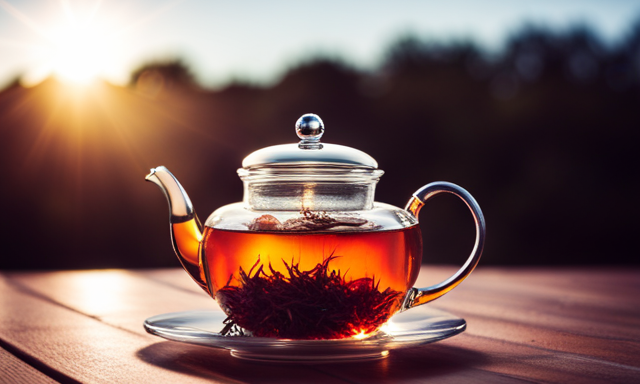Rooibos, the remarkable red tea from South Africa, has captured the hearts and taste buds of tea enthusiasts all over the world. But have you ever wondered how long it takes for this beloved beverage to undergo its unique oxidation process? Well, wonder no more! In this article, I will delve into the intricacies of rooibos oxidation and explore the factors that influence its duration.
First and foremost, let’s understand what oxidation means for rooibos tea. Oxidation is the chemical reaction that occurs when the tea leaves are exposed to air, resulting in the transformation of their flavors, aromas, and color. This process is crucial in determining the distinct characteristics of the final brew.
From the traditional rooibos to the more delicate green variety, we will explore the differences in oxidation time and how they affect the taste and aroma profiles of the tea. We will also dive into the art of roasting and aging rooibos, which further enhances its unique flavors.
So, grab your favorite mug and join me on this tantalizing journey through the world of rooibos oxidation. You’ll soon discover why this tea is truly a cup of liquid gold.
Key Takeaways
- Oxidation process is essential for rooibos, and it involves harvesting and fermenting the leaves.
- Longer oxidation period intensifies the taste and aroma changes in rooibos.
- Monitoring techniques, such as visual inspection and sensory evaluation, are used to control the oxidation process.
- Roasting and aging further enhance the flavor of rooibos, with different techniques creating varying toasty notes and caramelization.
What is Rooibos Tea?
Do you know that Rooibos tea is a delicious and refreshing herbal drink that originates from South Africa? It’s made from the leaves of the Aspalathus linearis plant, which is harvested using specific techniques to ensure the highest quality. The leaves are carefully selected and then cut to release the natural oils and flavors. This process helps to preserve the health benefits of Rooibos tea, which include its rich antioxidant content and potential immune-boosting properties. Drinking Rooibos tea has been linked to reducing inflammation, promoting heart health, and improving digestion.
Now, let’s talk about the oxidation process of Rooibos tea, which is essential in bringing out its distinct taste and aroma.
The Oxidation Process of Rooibos
When it comes to the oxidation process of Rooibos tea, there are three key points to consider: harvesting and fermentation, exposure to oxygen, and the duration of oxidation. Harvesting and fermentation play a crucial role in determining the flavor and quality of the tea. The leaves are carefully selected and left to ferment for a certain period of time. The exposure to oxygen during this process is carefully controlled to ensure the desired level of oxidation is achieved. The duration of oxidation, on the other hand, varies depending on the desired flavor profile. Longer oxidation results in a richer and deeper flavor.
Harvesting and Fermentation
Once you’ve harvested the rooibos leaves, it won’t be long before they start their delightful journey of oxidation. Harvesting techniques play a crucial role in ensuring the best quality leaves for fermentation. The leaves are carefully picked by hand, selecting only the tender young shoots, as they contain the highest concentration of essential oils and flavor compounds.
After harvesting, the leaves undergo a fermentation process, which is a key step in developing the characteristic taste and aroma of rooibos. During fermentation, the leaves are spread out in a thin layer and left to oxidize for a specific period of time, typically around 8 to 24 hours. This controlled oxidation process is what gives rooibos its signature reddish-brown color and enhances its flavor.
Once the fermentation is complete, the leaves are ready for the next stage, where they will be exposed to oxygen and undergo further transformation.
Exposure to Oxygen
After undergoing fermentation, the rooibos leaves are exposed to oxygen, allowing them to further transform and develop their unique characteristics. During this stage, several factors can influence the duration of oxidation, which plays a crucial role in the final flavor profile of rooibos.
Oxygen availability: The more oxygen the leaves are exposed to, the faster the oxidation process will occur.
Temperature: Higher temperatures can speed up oxidation, while lower temperatures can slow it down.
Humidity: High humidity levels can promote oxidation, while low humidity levels can hinder it.
Leaf moisture content: Leaves with higher moisture content tend to oxidize more quickly.
Leaf thickness: Thicker leaves may require a longer oxidation period to fully develop their flavors.
Understanding these factors is essential in determining the optimal duration of oxidation for rooibos leaves.
In the subsequent section, we’ll delve into the significance of the duration of oxidation in achieving the desired flavor characteristics.
Duration of Oxidation
The duration of oxidation for rooibos leaves significantly impacts the development of their unique flavor characteristics. The process of oxidation, also known as fermentation, is a crucial step in the production of rooibos tea. During this stage, the leaves are exposed to oxygen, which causes chemical reactions to occur, resulting in the distinct flavor and aroma of rooibos.
The duration of oxidation can vary depending on several factors, including the desired flavor profile and the specific processing techniques employed. Generally, rooibos leaves are allowed to oxidize for a period of 8 to 24 hours. However, factors such as temperature, humidity, and leaf moisture content can affect the oxidation time. These factors play a significant role in determining the final flavor and quality of the rooibos tea.
Moving on to factors affecting the oxidation time, temperature and humidity are key considerations.
Factors Affecting the Oxidation Time
When it comes to the oxidation process of rooibos, there are several factors that can affect the time it takes. First, temperature and humidity play a crucial role in determining how quickly the leaves oxidize. Higher temperatures and humidity levels can speed up the process, while lower temperatures and drier conditions can slow it down.
Additionally, the size and quality of the leaves can also impact the oxidation time. Smaller leaves tend to oxidize faster than larger ones, and higher quality leaves may oxidize more quickly due to their higher moisture content.
Finally, the processing techniques used can greatly influence the oxidation time. Different methods, such as rolling or crushing the leaves, can alter the surface area exposed to air and affect the oxidation process.
Temperature and Humidity
Contrarily, optimal temperature and humidity levels can accelerate the oxidation process of rooibos, resulting in a deeper and richer flavor profile. Just like a tea producer who successfully experimented with higher temperatures to produce a robust rooibos infusion, temperature control plays a crucial role in determining the final flavor of the oxidized leaves.
By carefully adjusting the temperature during the oxidation process, tea producers can achieve the desired level of oxidation and enhance the aromatic qualities of rooibos. Additionally, humidity also plays a significant role in the oxidation process. Higher humidity levels can speed up the oxidation, while lower humidity levels can slow it down. The interplay between temperature and humidity is essential for achieving the desired outcome.
Moving on to the next section about the size and quality of leaves, it is important to consider these factors in order to further understand the oxidation process.
Size and Quality of Leaves
Now let’s dive into the fascinating world of rooibos leaves and how their size and quality can influence the final flavor of our beloved infusion. The size of the leaves plays a crucial role in the oxidation process of rooibos. Larger leaves tend to oxidize at a slower rate compared to smaller leaves. This can have a significant impact on the flavor profile, as a slower oxidation process allows for more complex and nuanced flavors to develop. On the other hand, the quality of the leaves also plays a vital role. Leaves that are of higher quality, with minimal damage or disease, tend to produce a more flavorful and aromatic infusion. It’s important to carefully select and handle the leaves to ensure the best quality and flavor. Moving on to processing techniques, we can explore how these leaves are transformed into the delightful rooibos tea we enjoy.
Processing Techniques
To truly savor the rich flavors of your rooibos tea, let’s explore how the leaves undergo various processing techniques that transform them into the delightful infusion you enjoy.
The first step in the processing of rooibos leaves involves harvesting techniques. Farmers carefully select the mature leaves and stems, ensuring they’re at their peak for optimal flavor.
Once harvested, the leaves are then fermented, a crucial process that allows the leaves to oxidize. This oxidation process is what gives rooibos its distinctive reddish-brown color and enhances its flavor profile.
After fermentation, the leaves are dried to halt the oxidation process and preserve their unique characteristics. It’s worth noting that these processing techniques not only contribute to the flavor and aroma of rooibos tea but also help retain its health benefits.
Moving forward, let’s delve into the differences between traditional and green rooibos.
Traditional vs. Green Rooibos
In comparison to traditional Rooibos, green Rooibos oxidizes at a slower pace, akin to a snail inching its way forward. This slower oxidation process is what sets green Rooibos apart and gives it its unique characteristics. To better understand the differences between traditional and green Rooibos, let’s take a look at the table below:
| Traditional Rooibos | Green Rooibos |
|---|---|
| Fully oxidized | Partially oxidized |
| Earthy flavor | Fresh and grassy flavor |
| Rich in antioxidants | Higher levels of antioxidants |
| Calming and soothing properties | Boosts metabolism and aids digestion |
As you can see, traditional Rooibos is fully oxidized, resulting in an earthy flavor and calming properties. On the other hand, green Rooibos is only partially oxidized, giving it a fresh and grassy flavor along with higher levels of antioxidants. These differences in oxidation also contribute to changes in taste and aroma, which we will explore in the next section.
Taste and Aroma Changes During Oxidation
During oxidation, the taste and aroma of green Rooibos transform, akin to a caterpillar turning into a vibrant butterfly.
As the oxidation process progresses, the grassy and herbaceous flavors of green Rooibos give way to a richer, sweeter taste. The once mild aroma becomes more pronounced, releasing a delightful fragrance that’s reminiscent of honey and vanilla.
These taste and aroma changes occur due to the breakdown of certain compounds and the formation of new ones. The longer the oxidation period, the more pronounced these changes become.
It’s fascinating to witness how a simple cup of green Rooibos can be transformed into a complex and flavorful beverage.
Moving onto the subsequent section about monitoring the oxidation process, it’s crucial to understand the various factors that contribute to its successful completion.
Monitoring the Oxidation Process
The transformation of green Rooibos into a rich and flavorful beverage is a fascinating process that can be carefully monitored to achieve the desired result. Monitoring techniques play a crucial role in controlling the oxidation process of Rooibos.
One common method is visual inspection, where the color change of the leaves is observed. Initially, the leaves are bright green and gradually turn reddish-brown as oxidation progresses.
Another technique is sensory evaluation, where experienced tasters assess the aroma and taste profile of the Rooibos. They look for specific characteristics that indicate the optimal oxidation level, such as a balanced sweetness and a pleasant earthy undertone.
By using these monitoring techniques, oxidation control can be achieved, ensuring that the Rooibos reaches its full potential in terms of taste and aroma.
With this understanding of the oxidation process, we can now explore the next stage of roasting and aging Rooibos.
Roasting and Aging Rooibos
To achieve the desired flavor and aroma in your roasted and aged Rooibos, you’ll want to carefully monitor the oxidation process. Here are some key points to consider:
-
Roasting techniques: Roasting plays a crucial role in enhancing the flavor of Rooibos. Different techniques, such as pan-frying or hot-air roasting, can be used to achieve varying levels of toasty notes and caramelization. Experimenting with different roasting methods can help you find the perfect balance for your taste preferences.
-
Aging benefits: After roasting, allowing Rooibos to age for a certain period can further develop its flavors. The aging process allows the flavors to mellow and blend, resulting in a smoother and more complex taste profile. The duration of aging can range from a few months to several years, depending on personal preference.
By carefully roasting and aging Rooibos, you can unlock a delightful array of flavors and aromas. In the subsequent section, we will explore how different oxidation levels contribute to unique flavor profiles.
Different Oxidation Levels and Flavors
Experience the rich and captivating flavors that emerge when varying levels of oxidation are employed in the production of Rooibos. Oxidation levels play a crucial role in determining the flavor profiles and infusion times of Rooibos tea.
The health benefits of oxidized Rooibos tea are also influenced by the degree of oxidation. Lightly oxidized Rooibos retains more of its natural antioxidants, resulting in a tea that’s packed with health-promoting properties. On the other hand, heavily oxidized Rooibos develops deeper and more pronounced flavors, creating a robust and satisfying brew.
The infusion time for lightly oxidized Rooibos is shorter, allowing you to enjoy its delicate and nuanced taste quickly. In contrast, heavily oxidized Rooibos requires a longer steeping time to fully extract its bold flavors.
Transitioning into the subsequent section, let’s explore the benefits of oxidized Rooibos tea.
Benefits of Oxidized Rooibos Tea
Indulge in the rich and robust flavors of heavily oxidized Rooibos tea, while reaping its countless health benefits. Oxidized Rooibos tea boasts a distinct flavor profile that’s deep, earthy, and slightly sweet.
The oxidation process enhances the natural sweetness and imparts a reddish-brown color to the leaves, resulting in a more intense and complex taste. Not only does the oxidation process create a delightful sensory experience, but it also enhances the tea’s health properties.
The higher levels of oxidation in Rooibos tea lead to increased antioxidant content, which can support immune function, reduce inflammation, and promote heart health. Additionally, the oxidation process brings out more of the tea’s essential oils, providing a soothing and calming effect.
Transitioning into the subsequent section about brewing and enjoying oxidized Rooibos, one can truly appreciate the unique flavors and health benefits this tea offers.
Brewing and Enjoying Oxidized Rooibos
Immerse yourself in the rich, earthy aroma of a freshly brewed cup of oxidized Rooibos tea, allowing its complex flavors to transport you to a serene and calming oasis. To fully enjoy the experience, here are some brewing techniques and health benefits of oxidized Rooibos tea:
-
Water temperature: Use freshly boiled water that’s cooled slightly, around 176°F (80°C). This temperature allows the flavors to fully develop without becoming bitter.
-
Steeping time: Let the oxidized Rooibos tea steep for 5-7 minutes. This’ll extract the maximum flavor and health benefits from the leaves, resulting in a robust and satisfying cup.
-
Enhancements: Enjoy the tea as is, or add a touch of honey or a slice of lemon to enhance the flavors. Rooibos tea also pairs well with milk and can be enjoyed as a latte.
-
Health benefits: Oxidized Rooibos tea is rich in antioxidants, which can help boost the immune system, improve digestion, and promote overall well-being. It’s also caffeine-free, making it a perfect choice for those looking for a soothing and calming beverage.
Brewing and enjoying oxidized Rooibos tea is a delightful way to relax and reap the numerous health benefits it offers. So sit back, indulge in a cup, and let the flavors and healing properties of this wonderful tea envelop you.
Frequently Asked Questions
Can I speed up the oxidation process of rooibos tea?
I can speed up the oxidation process of rooibos tea by exposing it to higher temperatures and humidity. Accelerated oxidation can enhance the flavor and aroma of the tea, resulting in a richer and more robust taste.
Does the oxidation level affect the caffeine content of rooibos tea?
The oxidation level of rooibos tea does not affect its caffeine content, as rooibos is naturally caffeine-free. However, oxidation does impact the flavor profile. There is no recommended oxidation level for rooibos tea as it is typically not oxidized.
Can I use green rooibos for the same health benefits as oxidized rooibos?
Using green rooibos is like sipping from a fresh, untouched oasis, offering its own unique array of health benefits. However, the benefits of oxidized rooibos are still unparalleled in terms of depth and richness.
How long does it take for rooibos tea to reach its maximum oxidation level?
The oxidation process duration of rooibos tea varies depending on factors like temperature and humidity. Generally, it takes around 8 to 12 hours for rooibos tea to reach its maximum oxidation level.
Are there any risks or side effects associated with consuming oxidized rooibos tea?
There are no known risks or side effects associated with consuming oxidized rooibos tea. It is generally recommended to consume rooibos tea in moderation, with a recommended consumption level of 2-3 cups per day.
Conclusion
So, there you have it folks! After delving into the fascinating world of Rooibos tea, we’ve learned all about its oxidation process. Who knew that a simple cup of tea could be so complex? From the factors that affect oxidation time to the different flavors that result from varying levels of oxidation, there’s a lot to explore.
And let’s not forget about the benefits of oxidized Rooibos tea, which can be enjoyed in a variety of brewing methods. So, next time you sip on that delicious cup of Rooibos, remember the intricate journey it took to reach your mug.
Cheers!










